Discover various Calathea varieties and their unique features. Learn how to care for these stunning plants to keep them healthy and vibrant in your home.
Calathea plants, known for their striking foliage and air-purifying qualities, have become increasingly popular among indoor plant enthusiasts. These tropical beauties come in many varieties, each with its own unique patterns and colors. In this guide, we’ll explore some of the most popular Calathea types and provide essential care tips to help your plants thrive.
Popular Calathea Varieties
1. Calathea Orbifolia
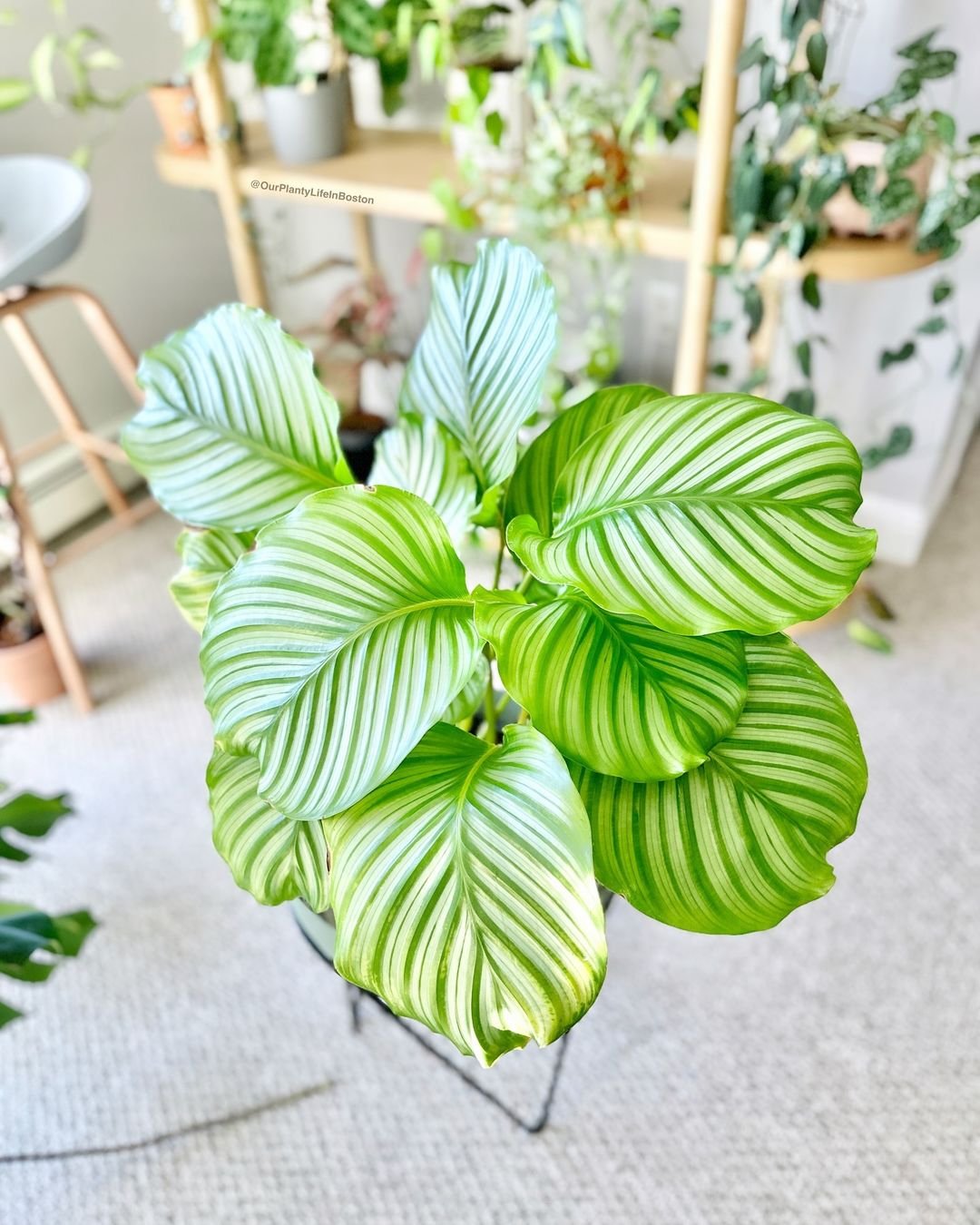
Here’s a straightforward and verified chart for the Calathea orbifolia:
| Category | Details |
|---|---|
| Botanical Name | Calathea orbifolia |
| Common Name | Orbifolia Calathea, Round Leaf Calathea |
| Plant Name | Orbifolia Calathea |
| USDA Hardiness Zone | 10-11 |
| Sun Exposure | Indirect light to low light |
| Soil Type | Well-draining, peat-based potting mix |
| Watering | Keep soil consistently moist; water when the top inch of soil feels dry |
| Growth Habit | Tropical perennial; clumping, bushy |
| Height/Spread | 2-3 feet tall; 2-3 feet wide |
| Special Features | Attractive, large, round leaves with striking patterns; improves indoor air quality; sensitive to direct sunlight and cold drafts |
The Calathea Orbifolia is a showstopper with its large, round leaves featuring silvery-green stripes. This variety can grow quite large, making it an excellent statement piece for your home.
Care tips:
- Prefers bright, indirect light
- Keep soil consistently moist but not waterlogged
- High humidity is crucial for this variety
2. Calathea Makoyana
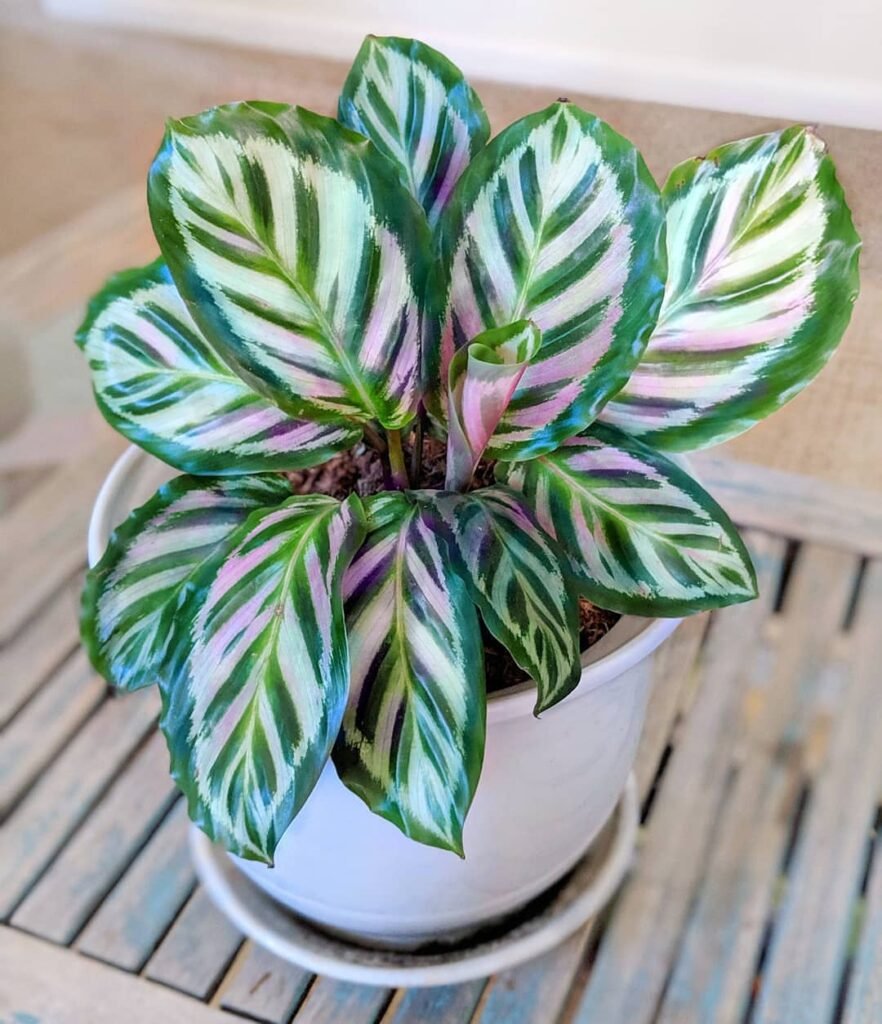
Here’s a detailed and verified chart for the Calathea makoyana:
| Category | Details |
|---|---|
| Botanical Name | Calathea makoyana |
| Common Name | Peacock Plant, Cathedral Window Plant |
| Plant Name | Peacock Calathea |
| USDA Hardiness Zone | 10-11 |
| Sun Exposure | Indirect light to low light |
| Soil Type | Well-draining, peat-based potting mix |
| Watering | Keep soil consistently moist; water when the top inch of soil feels dry |
| Growth Habit | Tropical perennial; clumping, bushy |
| Height/Spread | 1-2 feet tall; 1-2 feet wide |
| Special Features | Ornamental leaves with striking peacock-like patterns; improves indoor air quality; sensitive to direct sunlight and cold drafts |
Also known as the Peacock Plant, Calathea Makoyana has oval-shaped leaves with intricate patterns resembling peacock feathers. Its light green leaves are adorned with dark green markings and a purple underside.
Care tips:
- Thrives in low to medium indirect light
- Water when the top inch of soil feels dry
- Mist regularly to maintain humidity
3. Calathea Lancifolia
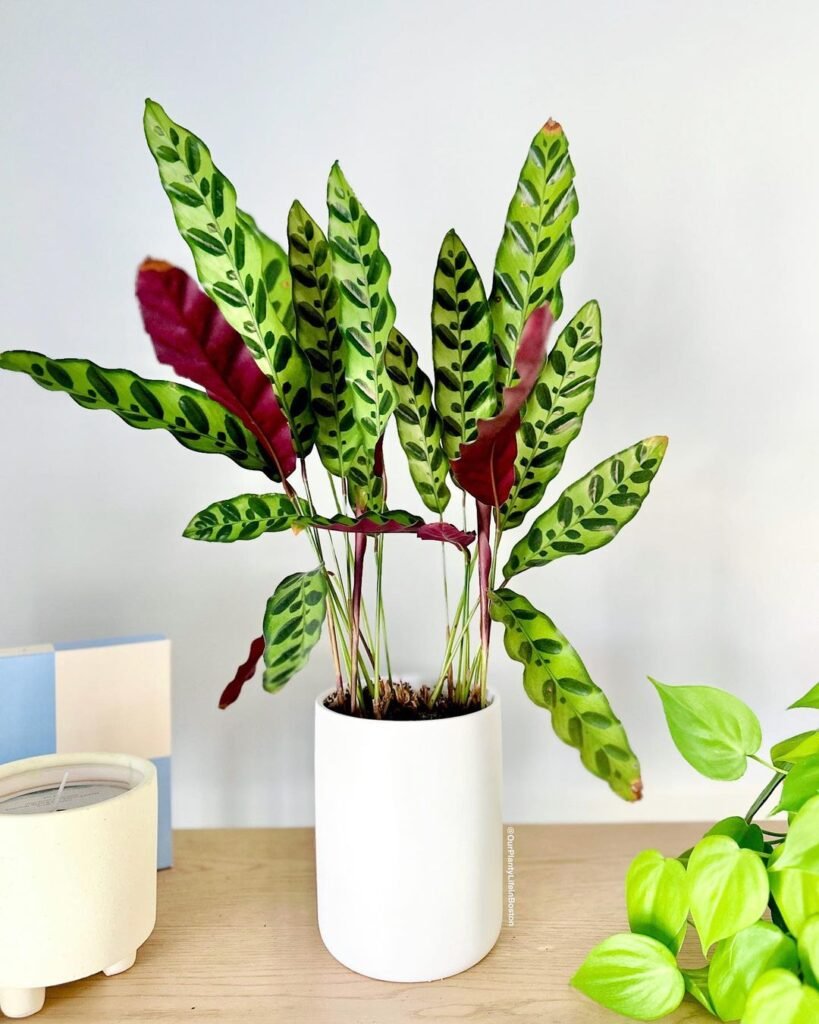
Here’s a straightforward and verified chart for the Calathea lancifolia:
| Category | Details |
|---|---|
| Botanical Name | Calathea lancifolia |
| Common Name | Rattlesnake Plant |
| Plant Name | Rattlesnake Calathea |
| USDA Hardiness Zone | 10-11 |
| Sun Exposure | Indirect light to low light |
| Soil Type | Well-draining, peat-based potting mix |
| Watering | Keep soil consistently moist; water when the top inch of soil feels dry |
| Growth Habit | Tropical perennial; clumping, bushy |
| Height/Spread | 1-2 feet tall; 1-2 feet wide |
| Special Features | Distinctive, elongated leaves with a unique pattern resembling a rattlesnake; helps improve indoor air quality; sensitive to direct sunlight and temperature extremes |
The Rattlesnake Plant gets its name from its long, narrow leaves with dark green spots that resemble snake skin. The undersides of the leaves are a deep purple.
Care tips:
- Tolerates lower light conditions
- Allow soil to dry slightly between waterings
- Benefits from occasional misting
4. Calathea Roseopicta
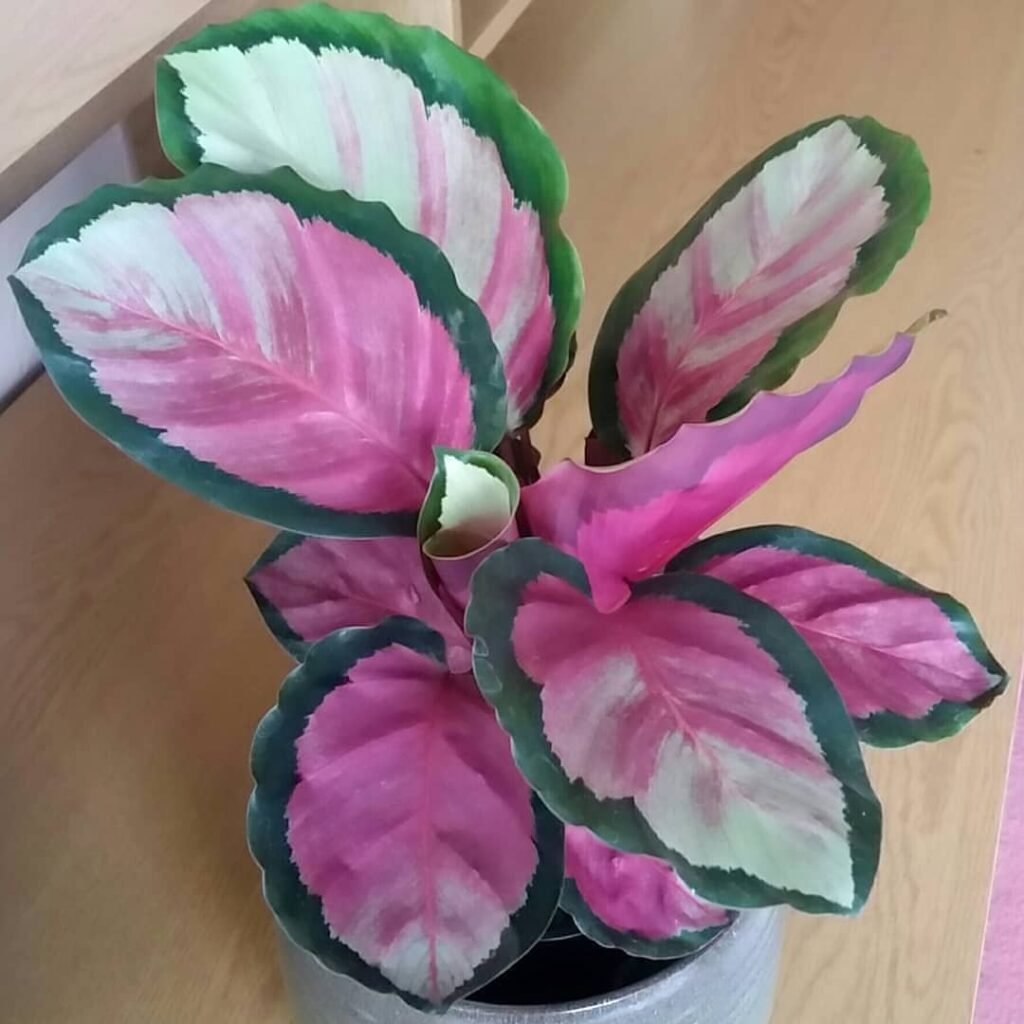
Here’s an easy-to-follow and verified chart for the Calathea roseopicta:
| Category | Details |
|---|---|
| Botanical Name | Calathea roseopicta |
| Common Name | Rose-Painted Calathea, Rose-Painted Prayer Plant |
| Plant Name | Rose-Painted Calathea |
| USDA Hardiness Zone | 10-11 |
| Sun Exposure | Indirect light to low light |
| Soil Type | Well-draining, peat-based potting mix |
| Watering | Keep soil consistently moist; water when the top inch of soil feels dry |
| Growth Habit | Tropical perennial; clumping, bushy |
| Height/Spread | 1-2 feet tall; 1-2 feet wide |
| Special Features | Attractive, colorful leaves with pink and green patterns; improves indoor air quality; sensitive to direct sunlight and cold drafts |
This variety features round leaves with striking pink or red lines radiating from the center, contrasting beautifully with the dark green background.
Care tips:
- Prefers medium to bright indirect light
- Keep soil consistently moist
- Requires high humidity to prevent leaf curling
5. Calathea Zebrina
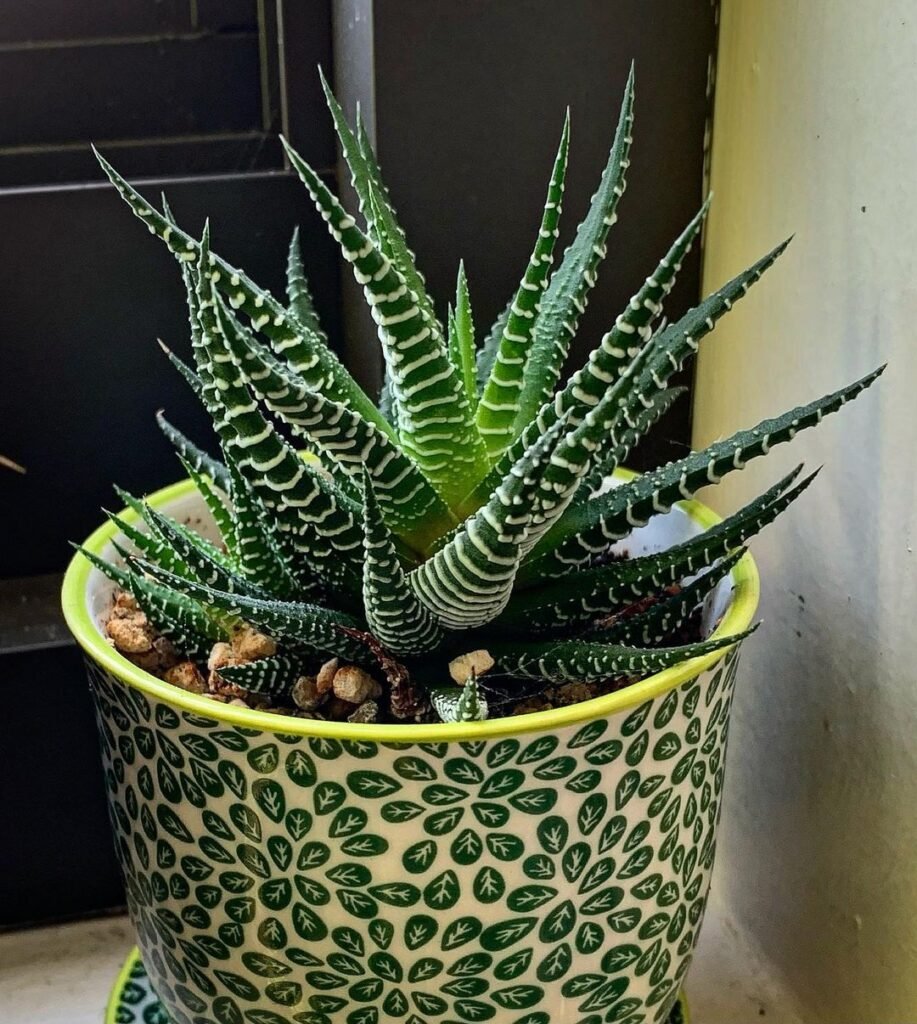
Here’s a clear and verified chart for the Calathea zebrina:
| Category | Details |
|---|---|
| Botanical Name | Calathea zebrina |
| Common Name | Zebra Plant |
| Plant Name | Zebra Calathea |
| USDA Hardiness Zone | 10-11 |
| Sun Exposure | Indirect light to low light |
| Soil Type | Well-draining, peat-based potting mix |
| Watering | Keep soil consistently moist; water when the top inch of soil feels dry |
| Growth Habit | Tropical perennial; clumping, bushy |
| Height/Spread | 1-2 feet tall; 1-2 feet wide |
| Special Features | Striking leaves with bold zebra-like stripes; improves indoor air quality; sensitive to direct sunlight and temperature extremes |
The Zebra Plant has large, velvety leaves with alternating light and dark green stripes, resembling zebra patterns.
Care tips:
- Thrives in low to medium indirect light
- Water when the top inch of soil is dry
- Appreciates high humidity levels
General Care Tips for Calathea Plants
While each variety has its specific needs, here are some general care tips that apply to most Calathea plants:
Light
Calatheas prefer bright, indirect light. Avoid direct sunlight as it can scorch their leaves. They can tolerate lower light conditions but may lose some of their vibrant colors.
Water
Keep the soil consistently moist but not waterlogged. Water when the top inch of soil feels dry. Use room temperature water, as cold water can shock the plant.
Humidity
High humidity is crucial for Calatheas. You can increase humidity by misting the leaves regularly, using a pebble tray filled with water or placing a humidifier nearby. For more detailed information on increasing humidity for houseplants, The Spruce offers an excellent guide with various methods you can try.
Soil
Use well-draining potting soil mixed with peat moss to retain moisture while preventing waterlogging.
Temperature
Calatheas thrive in temperatures between 65-80°F (18-27°C). Avoid cold drafts and sudden temperature changes.
Fertilizer
Feed your Calathea with a balanced, water-soluble fertilizer every 4-6 weeks during the growing season (spring and summer). Reduce or stop fertilizing in fall and winter.
Common Problems and Solutions
Even with proper care, you might encounter some issues with your Calathea. The Royal Horticultural Society provides comprehensive information on common houseplant problems, which can be helpful for diagnosing and treating issues with your Calathea. Here are some specific problems you might face:
1. Leaf Curling
Cause: Low humidity or underwatering Solution: Increase humidity and adjust watering schedule
2. Brown Leaf Edges
Cause: Low humidity, tap water with high mineral content, or too much direct sun Solution: Increase humidity, use filtered water and move the plant away from direct sunlight
3. Yellow Leaves
Cause: Overwatering or poor drainage Solution: Adjust watering frequency and ensure proper drainage
4. Fading Leaf Patterns
Cause: Too much direct sunlight Solution: Move the plant to a spot with bright, indirect light
Why Choose Calathea for Your Home
Calathea plants offer numerous benefits:
- They’re natural air purifiers, removing toxins from the air
- Their unique leaf movements (opening during the day and closing at night) are fascinating to watch
- The wide variety of patterns and colors can complement any interior design style
- They’re non-toxic to pets and children, making them safe for homes with furry friends and little ones
Where to Buy Calathea Plants
You can find Calathea plants at local nurseries, garden centers, home improvement stores with garden sections and online plant retailers. When purchasing, look for plants with vibrant, unmarked leaves, no signs of pests or diseases and moist but not waterlogged soil.
Wrapping Up
Calathea plants, with their stunning variety and air-purifying qualities, make excellent additions to any indoor garden. By understanding the needs of different Calathea varieties and following proper care guidelines, you can enjoy these beautiful plants in your home for years to come.
Remember, every plant is unique and it may take some time to find the perfect balance of care for your Calathea. Pay attention to your plant’s needs, and don’t be afraid to adjust your care routine as necessary. With patience and attention, your Calathea will reward you with lush, vibrant foliage that brings a touch of tropical beauty to your living space.
Happy planting!

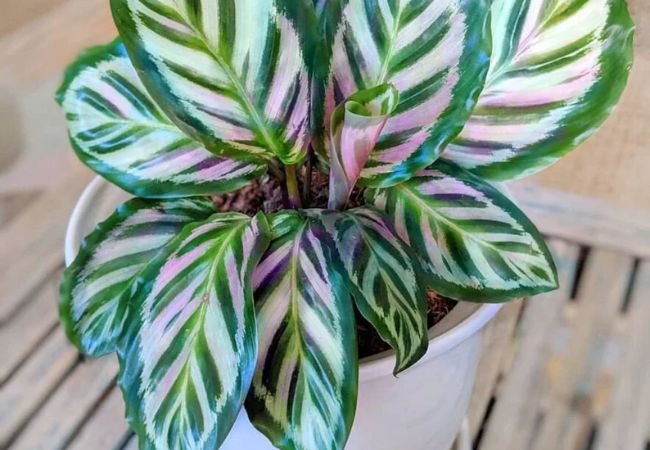

 I share tips, DIY projects, and inspiration for creating beautiful gardens. From beginner guides to expert advice on growing vegetables, herbs, and flowers, you’ll find everything to make your garden thrive. Discover seasonal gardening tips, plant care tricks, and sustainable practices. Follow for creative ideas to transform your outdoor space into a lush, green oasis. Let’s grow together!
I share tips, DIY projects, and inspiration for creating beautiful gardens. From beginner guides to expert advice on growing vegetables, herbs, and flowers, you’ll find everything to make your garden thrive. Discover seasonal gardening tips, plant care tricks, and sustainable practices. Follow for creative ideas to transform your outdoor space into a lush, green oasis. Let’s grow together!  #Gardening #PlantCare #GardenInspiration
#Gardening #PlantCare #GardenInspiration




Leave a Reply